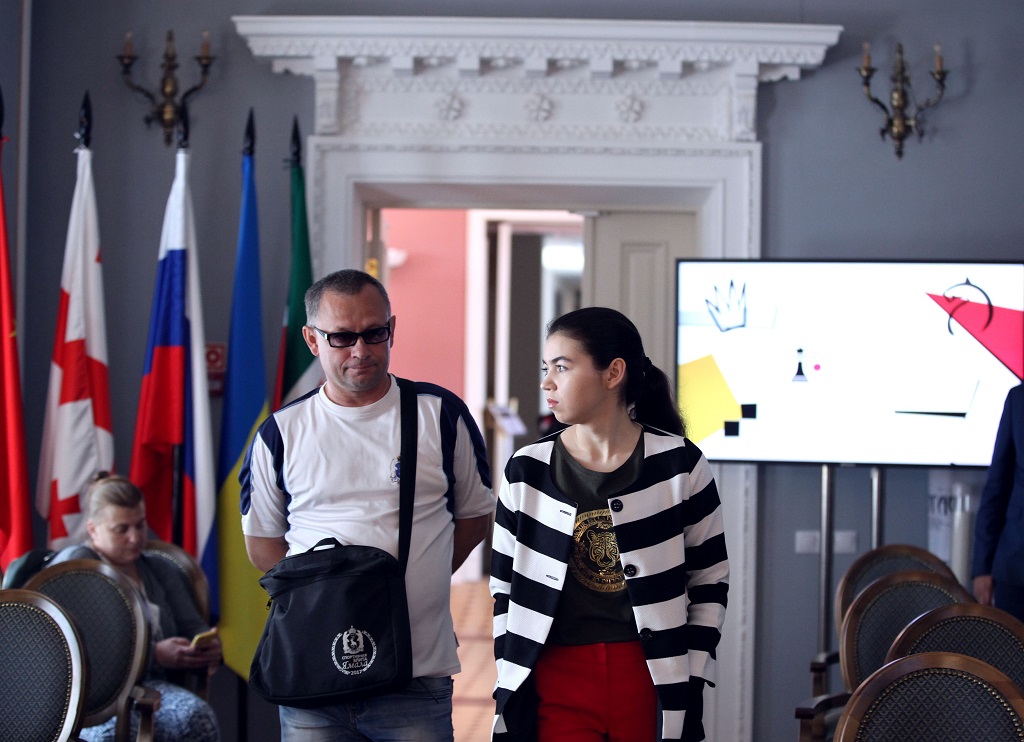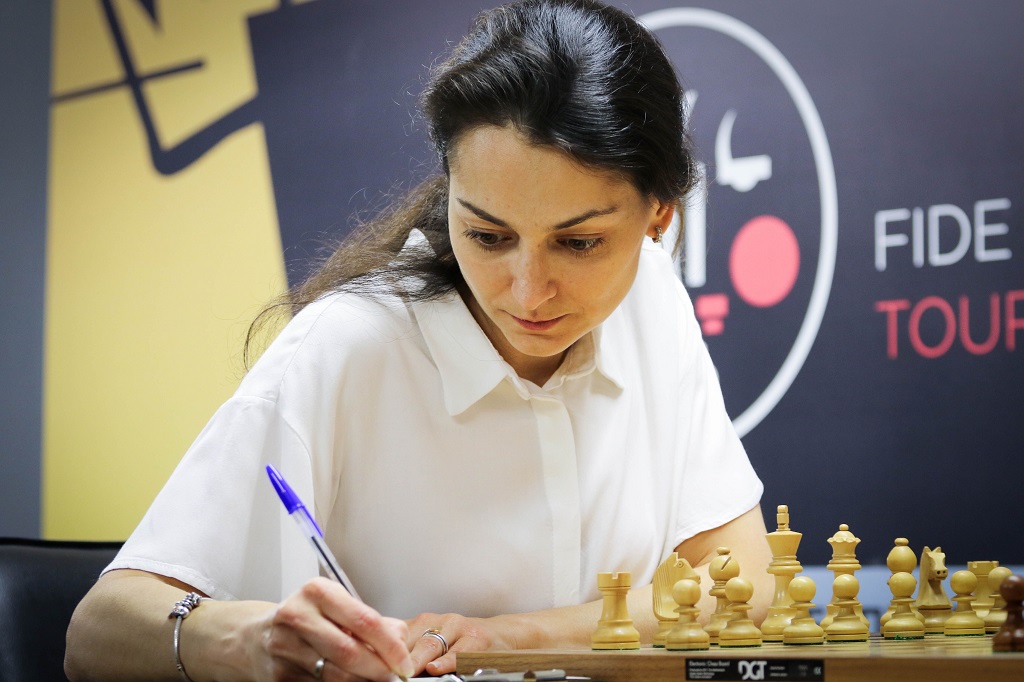


ChessBase 17 - Mega package - Edition 2024
It is the program of choice for anyone who loves the game and wants to know more about it. Start your personal success story with ChessBase and enjoy the game even more.
After concluding a "mini round robin" in the first three rounds, the Russian players in Kazan started taking on the "international" participants (this event requires all compatriots to face each other first to avoid any sort of collusion). Coincidentally, in round five, they all had the white pieces. Two of them got victories, while the other two achieved winning positions but could not turn them into full points.
The youngest player in the field, 20-year-old Aleksandra Goryachkina, is now the sole leader of the tournament on an impressive 4/5 score. Nana Dzagnidze stands a half point behind her, while the oldest player in the field, 35-year-old Alexandra Kosteniuk, now shares third place with Tan Zhongyi and Kateryna Lagno, all on 2½/5. The Muzychuk sisters had a tough time in round five, but ended up saving half points — nonetheless, they are sharing last place after collecting 1½ points each.

The live audience following Sergey Shipov's commentary | Photo: Eteri Kublashvili
The players followed a line of the Catalan recently seen in Shenzhen, where Richard Rapport and Yu Yangyi split the point after 31 moves. Much like in the predecessor encounter, Goryachkina and Tan Zhongyi reached a double rook endgame with four pawns per side — in Shenzhen, however, the pawn structures were symmetrical, while in Kazan White had 4 v 3 on the kingside, with more active rooks to boot:
Power Play 24: A repertoire for black against the Catalan
On this DVD Grandmaster Daniel King offers you a repertoire for Black against the Catalan, based around maintaining the rock of a pawn on d5. Keeping central control ultimately gives Black good chances to launch an attack against the enemy king.
This seems to be a rather harmless position, but White is certainly the one with chances to put pressure on her rival...if she manages to keep the initiative. Goryachkina did precisely that, by doubling her rooks on the seventh rank and mobilizing her kingside majority. Eventually, the youngster gobbled up Black's a-pawn and, when Tan Zhongyi was trying to keep the balance in a 3 v 2 rook endgame, Aleksandra exploited an inaccuracy by the Chinese to get a decisive advantage:
Instead of the Tan Zhongyi's 48...♚f6, 48...♚f8 was more resistant, as Black would be able to get an endgame in which White keeps the f and h-pawns (always a difficult setup to convert into a win), while in the game Goryachkina got to keep two connected passers on the e and f-files. We cannot blame Tan Zhongyi, though, as she was in a very difficult position already — and finding precise defensive continuations in these endgames is a taxing endeavour!
In the end, Goryachkina won the game after 62 moves.

Aleksandra Goryachkina with her father Yuri (a FIDE Master), who usually travels with her | Photo: Anastasiya Karlovich
The two contenders tend to skew towards dynamic positions, in which the initiative is the main asset in dispute. Kosteniuk decided to surprise her opponent with the Alapin Variation of the Sicilian Defence, going for a line that is rarely seen in the elite. Early on, the Russian offered a pawn sacrifice, which was rejected by her opponent:
Sicilian Defense with 2.c3 - Alapin Variation
Sergei Tiviakov started playing the line 1.e4 c5 2.c3 in the Sicilian Defence as White in 1988. Since then, he has employed it in more than 100 games, including a yearlong period when he I managed to win twelve 2.c3-games in a row. White tries to occupy the centre with a second pawn, and Black must know his stuff very well in order to be able to equalize. And this is only possible with 2...Nf6 – all other lines give the first player a small edge everywhere. Especially against stronger opponents, 2.c3 is an excellent weapon.
After 9.d5 exd5 10.cxd5 Black can capture the central pawn both with the queen or the knight (in the last game that reached this position, from 1993, Black took with the queen). Nana Dzagnidze, though, decided to go for 10...♝d6, after thinking for over twenty minutes.
In the middlegame that ensued, Nana chose not to castle — instead, she "hid" her king on f8. It was very hard to evaluate the position, as both players had active chances at their disposal. Only when the time control was approaching, Dzagnidze faltered:
Feel free to move the pieces on the diagram above
Better than Nana's 36...♜h4 was 36...♘b1. After the text, Kosteniuk found the correct sequence to punish the bad placement of Black's rook — 37.♘g5+ ♚g6 38.♘f3 and it is very hard for Black to untangle. There followed 38...♜e4 39.g4 ♞b1 40.♗c2, with the light-squared bishop on the same diagonal as Black's rook and king. Nana resigned two moves later.

Former Women's World Champion Alexandra Kosteniuk | Photo: Eteri Kublashvili
While Kosteniuk played 2.c3 against Dzagnidze's Sicilian, Valentina Gunina decided on 3.b3 against Mariya Muzychuk's 1...c5 2.♘f3 e6. In this game, however, the players left theory on move six, which prompted Gunina to spend over 17 minutes on move eight. The Russian kept taking her time in critical positions during the opening, and that resulted in her getting a considerable advantage later on. Sadly for her, though, she failed to find a nice shot that would have decided the game in her favour, while already in deep time trouble:
The Sicilian Gashimov Variation
The variation 1.e4 c5 2.Nc3 d6 3.d4 aims to throw Black off his normal game right from the word 'go', where he'll be forced to play accurately and deal with a number of intricate nuances just to get an equal position.
Gunina played 31.♘h6 and allowed Muzychuk to get back in the game, which eventually led to a 72-move draw. Valentina, instead, could have gone for 31.♕e7+! and after 31...♜xe7 32.♖xd8+ ♚f7 White has the fork 33.♘d6+, with a clear exchange to the good.

Valentina Gunina smiling before the battle begins | Photo: Eteri Kublashvili
In the post-game interview, a disappointed Gunina confessed she could not really calculate any lines in the critical positions with so little time on her clock.
The older Muzychuk sister, Anna, opted for the Ruy Lopez against Kateryna Lagno. The latter got a positional edge right from the get go, with Anna describing her play as "quite artificial from the very beginning" (e.g. 19...♞h8?!). Lagno naturally felt she was on top, but could not find a way to turn that into a tangible advantage. On move 18, for example, she could have chosen a more active plan:
New Developments in the Arkhangelsk Variation
Mikhalchishin's new work sheds light on fresh ideas in the hyper-sharp c3 variation, the classical line, which is specially well played by Caruana, as well as further entertaining developments in the Semi-Arkhangelsk with a temporarily delayed b7-b5.
Kateryna chose the prophylactic 18.b3, when the more straight-forward alternatives 18.g4, 18.♘g3 or 18.a4 would have kept her initiative alive. Muzychuk knew at this point that she was in trouble and went on to find good continuations until restoring the balance. The draw was signed after 31 moves.

Kateryna Lagno | Photo: Eteri Kublashvili
Commentary provided by GM Evgeny Miroshnichenko and IM Elisabeth Paehtz